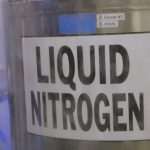What problems currently exist for cryopreservation?
- Freezing damage When the brain freezes, ice crystals begin to develop in the extracellular space (ice does not form inside brain cells because there is much more water and ice nucleation material in the space outside and around neurons). The ice that forms is pure water, which causes the concentration of solutes in the remaining non-frozen water to skyrocket. Water leaves the cells, to restore osmotic balance, and the cells are crushed by the osmotic stress.
- Cryoprotectant damage and tissue dehydration Cryoprotectants help to prevent freezing damage. If there is a high enough concentration of cryoprotectant present in a piece of tissue when it begins to freeze, the water will become steadily more viscous and eventually transition to a solid, amorphous, glassy state instead of freezing. This glass transition or vitrification stops the crushing damage that would otherwise occur during freezing.Unfortunately, the concentration of cryoprotectant must be quite high to cause vitrification instead of freezing. At the concentrations required to protect the brain from freezing, the cryoprotectant is toxic. However, the toxicity of cryoprotectant is itself a function of temperature. The lower the temperature, the less toxic the cryoprotectant is. As the cryoprotectant is added to the brain, it exerts osmotic pressure, because the cryoprotectant solution has a higher concentration of solutes than the fluid that is normally in the brain. If the cryoprotectant is added too fast, it will cause brain cells to shrink and severely dehydrate them, possibly destroying neural ultrastructure.
Thus, adding cryoprotectant is a delicate balancing act between ramping up the concentration and lowering the temperature. Finding the right balance is a core challenge for cryopreservation. One proven way to prevent dehydration in small neural samples today is to first fix brain tissue via an aldehyde (chemopreservation) then to administer cryoprotectant and engage in cryopreservation. It is possible, though unverified today, that such a “hybrid” (chemo+cryo) technique may turn out to be the most reliable way to preserve neural ultrastructure for whole brains.
- Cracking As the brain is cooled to the glass transition temperature, it can sometimes crack mechanically. Using annealing can reduce the probability of cracking.
- Incomplete perfusion of cryoprotectant Cryoprotectant is delivered via perfusion. If the vasculature of the brain is damaged in some way, and the cryoprotectant does not reach a certain part of the brain, then that brain region will freeze instead of vitrify and be damaged by the crushing osmotic forces exerted by ice crystals.






